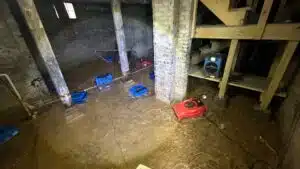Water damage can wreak havoc on any structure, compromising the integrity and safety of your building. Whether from leaking pipes, heavy rains, or flooding, water damage can have severe effects on various building materials. Understanding how different materials react to moisture can help homeowners and building managers take the necessary steps to mitigate and repair water damage. In this article, we’ll explore the effects of water damage on wood, drywall, and concrete, and offer guidance on how to protect your structure.
The Impact of Water Damage on Wood
Wood is a popular building material used in homes for flooring, framing, and cabinetry. However, it is also highly susceptible to water damage. When exposed to moisture, wood can absorb water, leading to swelling, warping, and the growth of mold and mildew. Over time, water-damaged wood can deteriorate, causing it to lose its structural integrity.
If your wood surfaces have been exposed to water, it’s important to dry them thoroughly as soon as possible. The longer wood stays wet, the more likely it is to develop long-term issues. water damage building materials can also result in discoloration, staining, and an unpleasant odor. In cases of extensive damage, it may be necessary to replace the affected wood entirely.
How Drywall Reacts to Water Damage
Drywall is another commonly used material in building construction, primarily for interior walls and ceilings. It is highly susceptible to water damage, as it easily absorbs moisture, leading to softening, sagging, and eventual collapse. Water damage to drywall often leads to visible discoloration and stains, especially if the moisture comes from leaks or floods.
One of the most concerning effects of water damage on drywall is the potential for mold growth. Since drywall contains paper, it creates an ideal environment for mold and mildew to thrive. Mold can spread quickly in water-damaged areas, leading to health hazards and further damage to the material. If your drywall has sustained significant water damage, it’s essential to remove the damaged portions and replace them to ensure the safety and health of your building.
Concrete’s Resistance and Vulnerabilities to Water Damage
Concrete is known for its durability and resistance to water damage compared to materials like wood and drywall. However, concrete is not impervious to water. Over time, moisture can seep into the porous surface of concrete, causing damage. When water enters the concrete, it can lead to cracks, rusted reinforcement bars, and efflorescence—white, chalky deposits that form on the surface due to mineral salts in the water.
Common Effects of Water Damage Across Materials
While different building materials react to water damage in unique ways, some effects are common across all materials. For instance, one of the most frequent consequences of water exposure is the development of mold and mildew. These fungi thrive in damp conditions and can cause significant health problems if left unchecked. The longer materials are exposed to water, the greater the risk of mold growth, which can spread throughout the structure.
Additionally, water damage effects can weaken the structural integrity of the building. Whether it’s rotting wood, crumbling drywall, or cracking concrete, the effects of water damage on building materials can compromise the safety of the structure. In some cases, water damage can be so severe that it leads to the need for extensive repairs or complete replacement of affected materials.
Prevention and Mitigation of Water Damage
The best way to prevent water damage from affecting your building materials is through proactive maintenance and timely repairs. Regularly inspect your building for signs of water damage, such as leaks, discoloration, or musty odors. Ensure that your roofing, plumbing, and drainage systems are in good working order to prevent water infiltration.
Conclusion
Understanding the effects of water damage on building materials like wood, drywall, and concrete is crucial to maintaining the safety and integrity of your structure. While water can damage any material, the level of destruction varies depending on the material’s properties and how long it has been exposed to moisture. To prevent long-term damage, it’s essential to act quickly and invest in regular maintenance and repairs. If your building has suffered water damage, contacting professionals from a reputable service like WaterdamageProsNashville.com can help ensure proper restoration and protection against future issues.

